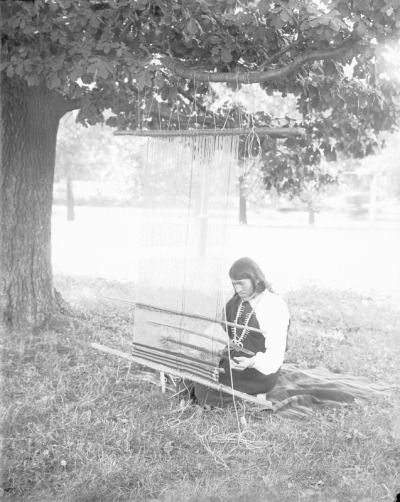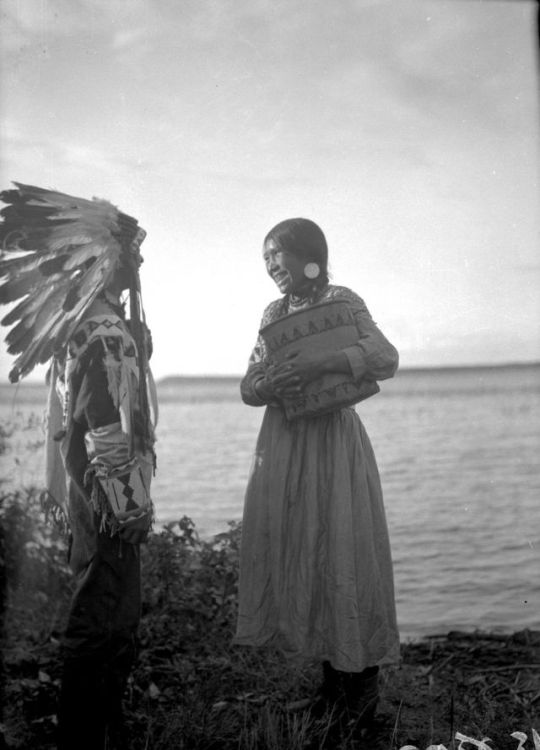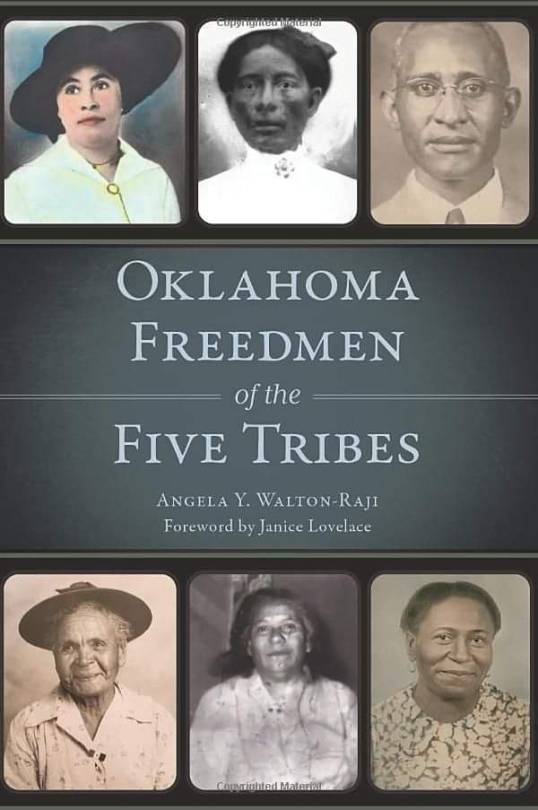#native history
Text
23K notes
·
View notes
Photo

Monsheeda (Dust Maker), and his wife Mehunga (Standing Buffalo), of the Indigenous Ponca tribe, posed together in their wedding photo, circa 1900
#native history#indigenous history#indigenous culture#ndn#i just love this pic sm im sorry i had to post it#mine
18K notes
·
View notes
Text

Lucinda Davis (c. 1848-after 1937) was a slave who grew up in the Creek Indian culture. She spoke the Muskogee Creek language fluently. The main information source was from an interview in the summer of 1937, at which time she was guessed to be 89 years old. Lucinda's parents were owned by two different Creek Indians. Being enslaved so young without her parents, she never found out her birthplace, nor the time of her birth. Her mother was born free in African when she escaped her captors either by running away or buying back her freedom, the white enslaver, who was also the mother's rapist and father of Lucinda, sold their child to Tuskaya-hiniha. Lucinda was brought up in The way the Creeks treated slaves was considered a much different and kinder form of slavery than the way the white Americans, Cherokee, or Choctaw went about it. Families could work under different slave owners and did not have to live on the same property as whom they worked for. The slaves worked quite hard and were paid, but had to give most of their pay to their owners, being allowed to keep a small amount. Lucinda was treated as a family member and did her duties. Her responsibility was taking care of the baby, amongst being an extra hand for cleaning and cooking here and there. She was not beaten or disrespected. It was understood what was needed of her, and she followed along.
#black history#native american tribes#native#black tumblr#black history month#oklahoma history#black literature#american slavery#african slavery#black community#civil rights#native history#lucinda davis#black history is american history#american history
453 notes
·
View notes
Note
Hello. This is a rather mundane question considering all the things, but I got curious. Does Hebrew have accents? How do they vary in and out of Israel?
I understand if you choose not to reply as this is a difficult time for you. In any case, take care🩷🩷🩷
Hi Nonnie! No, don't worry, all questions that are truly interested in Jewish culture are welcome! ^u^
TBH, something to remember about Hebrew is that it has quite a unique history. To the best of my knowledge, it is the only language that was used on a daily basis as the lived in language of a native population, then "died" as a result of Jews being exiled. As they found themselves in other countries, they had to speak the local language. They didn't abandon Hebrew, but it stopped being the langauge in which they lived their daily lives. Hebrew became the language of prayer, of scripture study, and terms from it bled into the local languages Jews spoke, creating Jewish versions of these languages (Yiddish being the Jewish version of German, Ladino being the Jewish version of Spanish, Yevanik being the Jewish version of Greek, and there are also Jewish versions of Arabic and other languages, too), so Hebrew still had an impact on Jews, and they were still connected to it... but it was no longer a "living" language. It was closer to what Latin is today. A language in which religious ceremonies are conducted, that theologians study, but not a language that anyone conducts their daily life in.
Then, as a part of the project of reclaiming and reviving the Jewish native life in Israel that came to be known as Zionism, people set out to revive our native language, too. There was a realization that it had to be adapted to modern life, give it terms for things that didn't exist 2,000 years ago, so it would be useful for people who wanted to conduct their daily lives in Hebrew again. And that's how the last of the Canaanite languages became the only "dead" language to be revived, and return to be the lived in language of its native people.
I mention this unique history, because modern Hebrew isn't the same as biblical Hebrew (though about 60% of modern Hebrew IS biblical). It means if there were different Hebrew accents during biblical times, we don't know it for sure.
At the same time, the fact that Jews were spread out in the diaspora, and their pronunciation of Hebrew (as a dead language) came to be influenced by the local languages they spoke while in exile. So a Jew who returned to Israel from the diaspora in Germany, a Jew who returned to Israel from the diaspora in Argentina, and a Jew who returned to Israel from the diaspora in Yemen do not have the same accent when speaking Hebrew.
But these are not considered regional accents of Hebrew in the same way that you can find different regional accents of English when traveling across England... If we put aside the accents of Jews returning to Israel, and instead we look at the accents of Jews born in Israel, the ones born into speaking modern Hebrew, there's a myth of a Jerusalem accent. I say myth, because you'll hear all over Israel people swearing, that Jerusalemites pronounce a few words differently. The most common example is the word 'mataim' (which means two hundred), and many Israelis insist Jerusalemites pronounce it ma'ataim, with the first vowel prolonged and emphasized. I have lived in Jerusalem since 2002 and I have never heard it. I think in this sense, regional accents are usually, at least in part, a product of geography. It determines how far apart people live, how much they interact, how much they hear others speaking the same language as they do. The smaller a country, and the easier travel in it is, the fewer accents it's likely to produce. And I think that's the main reason why there aren't really accents in Israel (other than those of people who came to speak Hebrew as a second language), because it's a very small country, and because today, it's pretty easy to travel in it (you can cross it from the most northern point to the most southern one in slightly over 5 hours).
I hope that kind of answers it? Thank you for the kind words, I hope you're well, too! xoxox
#ask#anon ask#israel#hebrew#jewish history#jewish#jew#jews#jumblr#frumblr#native israeli#native history#cultural revival#language revival#native revival
79 notes
·
View notes
Note
What is Turtle Island?

55 notes
·
View notes
Text
While you’re out celebrating the “holidays”, please remember the genocide that comes with this holiday.
Remember the Natives torn from their land, the land western society claims their own.
Remember the thousands of bodies of children found and still not found underneath assimilation, Native American boarding schools.
Remember the natives the were killed for fun, killed trying to keep their sacred practices, killed for just trying to exist.
47 notes
·
View notes
Photo


Pride 2022 05/30 - We’wha
Born c.1849 at Zuni (now in New Mexico), We’wha was a lhamana - a Zuni gender including both masculine and feminine roles. Lhamana in general and We’wha in particular were recognised as highly skilled craftspeople.
In 1885, We’wha travelled to Washington DC as a representative of the Zuni people, where they worked with anthropologists and the Smithsonian museum to demonstrate and share information about Zuni crafts and culture.
learn more with queer as fact: a queer history podcast
[Image description: We’wha, a Zuni lhamana with a dark bob, wearing a Zuni dress, blanket and necklace (1894); We’wha seated under a tree weaving on a loom suspended from a branch above]
#we'wha#pride 2022#pride#queer history#lgbt history#trans history#two spirit#indigenous history#native history#zuni
478 notes
·
View notes
Text
Witty Cudjoe
It's Black History Month in the United States, and I want to share the story of my 3rd Great Grandfather, Witty Cudjoe.
Born in 1830 during the Seminole Wars in Florida, Witty Cudjoe shared his memories in a newspaper article published when he turned 105. Witty's heritage is a legacy of warriors, tracing back to his grandfather, King Cudjo.
King's journey from slavery in the Carolinas to freedom in Spanish Florida in the 1700s marked the beginning of a lineage that shaped the Seminoles. Witty's father and grandfather fought alongside fellow Seminoles, facing Andrew Jackson and the United States Army.
Witty also discussed the removal to Indian Territory after a deceptive treaty with the United States. Despite being initially enslaved, Witty later fought as a Loyal Seminole, securing his freedom. He helped in the establishment of Wewoka, emerging as an important figure in his community.
During a time marked by the exploitation of Native Americans, Witty and his wife Mariah faced attempts to manipulate them out of their land allotments. Despite being unable to read or write, Witty took legal action and won, a remarkable feat at the time.
Witty's courage and determination defined his story, blessing future generations through the land he secured. Despite challenges posed by statehood, Witty leased 10 acres of his land to establish a school, preserving the Muscogee language and Seminole culture for his children. Witty lived to the age of 116, passing away in 1946.
During my last visit to Oklahoma, I met a 94-year-old cousin who had cared for Witty in his later years. Hugging her felt like reaching back through time, expressing gratitude to Witty for my existence.
Reflecting on our history, I see similarities with other communities, such as the Palestinians fighting for freedom. Like the Palestinians, they too faced forced displacement and theft of identity. Despite everything, our ancestors stood strong, and our community perseveres.
In solidarity with the Palestinian community, I commemorate Black History Month, acknowledging shared struggles. I hope that by standing together, we can illuminate the path home for all displaced people someday.





6 notes
·
View notes
Text
𝕣𝕖𝕤𝕖𝕒𝕣𝕔𝕙 𝕡𝕣𝕠𝕛𝕖𝕔𝕥: 𝕓𝕦𝕣𝕖𝕒𝕦 𝕠𝕗 𝕚𝕟𝕕𝕚𝕒𝕟 𝕒𝕗𝕗𝕒𝕚𝕣𝕤

When the factory fur trade of North America was abolished in 1822, the US Government was left searching for a way to maintain control in Indian territories. John C. Calhoun, then Secretary of War, created the “Bureau of Indian Affairs (BIA)” on March 11, 1824. He did so without authorization from Congress, which is against the general practice although not expressly forbidden by the Constitution. John Calhoun would go on to become the Vice President of the United States the following year.
1825 was an interesting year in US history, representing the end of the Era of Good Feelings that followed the War of 1812. The presidential election would split the previous first party system into the Democrat and Republican system we now know today. The country was taking its first steps to limit the expansion of slavery into its newly aquired territories. As Jacksonian Democracy extended the privilege of voting to most white men aged 21 or older, removing the previous requirement to own land, racist and colonial mentalities spread in the form of “manifest destiny”. The US needed to remove Indian peoples from their homelands and they needed a way to do it.
The Bureau of Indian Affairs would go on to forcibly remove native peoples from their nations under the direction of Senator and then Secretary of State, John C. Calhoun. In the late 1800’s, after succeeding in removing many tribal nations from their homelands, the Bureau of Indian Affairs created the Residential Schooling system to assimilate Indian children into American culture. Missionaries had already established the practice, but the Bureau of Indian affairs built their schools specifically off-reservation and incorporated “students” from a variety of different tribes to aid in their goal of assimilation. Their model was the infamous Carlisle Indian Industrial School in Pennsylvania.
The 1960’s and 1970’s saw a rise in activism for and among American Indians. The Bureau faced a number of displays of public opposition by Indian people and those who supported them, like the 1972 Occupation of BIA Headquarters. Today, the Bureau of Indian Affairs is responsible for quite a few different things, all concerning the affairs of American Indian people on Tribal lands.
The Bureau as a whole is responsible for the federal recognition of tribes, most recently the Little Shell Tribe of Montana. The Office of Field Operations is responsible for regional operations, working with tribal governments on the management of natural resources, agriculture, fish and wildlife, and parks. The Office of Justice Services operates several programs and also provides funding for law enforcement, tribal courts, and detention facilities on federal lands. Their jurisdiction is surprisingly expansive, holding authority over all crimes committed on reservations and all federal crimes, as well as all crimes committed within “dependent Indian communities” or on trust lands. It is also the responsibility of the OJS to enforce tribal criminal codes and assist tribes in maintaining their courts and justice systems. They also operate the Indian Police Academy, where agents are trained to work specifically in Indian Country. The Office of Trust Services is responsible for overseeing land and resources that are recognized as tribal but owned in trust by the US federal government. Finally, the Office of Indian Services comprises a wide range of different programs, including social services and child welfare, transportation infrastructure, awarding federal funds to tribes, and providing resources to tribal governments. It is generally in their mission statement and enumerated responsibilities to uphold tribal sovereignty under the Indian Self Determination and Education Assistance Act.
Sources: x.x.x.
#history#anthropology#native american studies#bureau of indian affairs#natives in academia#native history#indigenous#studyblr#natives on tumblr#indigenous people#native americans#land back#american history#john c calhoun
76 notes
·
View notes
Photo

Indigenous couple, circ. early 1930′s
[ID: Antique photograph of a young Indigenous couple, a man and a woman, standing beside a lake. The woman faces the man, smiling, holding a woven basket. The man is dressed in traditional regalia, including a feathered headdress. End ID]
663 notes
·
View notes
Text

My family Chickasaw Freedmen.
#chickasaw freedmen#black history#black tumblr#native american tribes#black literature#native history#black community#black history is american history#native american history#native americans#black lives matter#american history
235 notes
·
View notes
Text
instagram
#free palestine#palestine#from the river to the sea palestine will be free#please talk about palestine#save palestine#the voice of palestine#genocide#end genocide#fyppage#tmblr fyp#fyp#instagram#instagram fyp#tiktok#history#native history#colonization#usa history#end colonialism#daily post
5 notes
·
View notes
Text

I've waited 2 months for this to be available
The book was noteworthy for its relevance to the Alcatraz-Red Power Movement and other activist organizations, such as the American Indian Movement, which was beginning to expand. Deloria's book encouraged better use of federal funds aimed at helping Native Americans. Vine Deloria, Jr. presents Native Americans in a humorous light, devoting an entire chapter to Native American humor. Custer Died for Your Sins was significant in its presentation of Native Americans as a people who were able to retain their tribal society and morality, while existing in the modern world.
From wiki
The book description:
"In his new preface to this paperback edition, the author observes, "The Indian world has changed so substantially since the first publication of this book that some things contained in it seem new again." Indeed, it seems that each generation of whites and Indians will have to read and reread Vine Deloria’s Manifesto for some time to come, before we absorb his special, ironic Indian point of view and what he tells us, with a great deal of humor, about U.S. race relations, federal bureaucracies, Christian churches, and social scientists. This book continues to be required reading for all Americans, whatever their special interest."
#vine deloria jr#custer died for your sins#indigenous activists#us history#native history#american history#indigenous liberation#native liberation#native books#indigenous books#american indian movement#Alcatraz Red Power movement#decolonize#decolonization
18 notes
·
View notes
Text
i will never not talk about how important it is to consume other literature written by marginalized communities and different communities than your own.
native american literature is some of the most beautiful literature i’ve ever studied and engaged in.
here’s some recs!!
Poetry
she had some horses by joy harjo
selu: seeking the corn mother’s wisdom (also as fiction and non-fiction) by marilou awiakta
whereas by layli long soldier
fiction
solar storms by linda hogan
there, there by tommy orange
ceremony by leslie marmon
13 notes
·
View notes
Text
youtube
This made me cry bro… 🦬
Actually gives me hope…
3 notes
·
View notes
